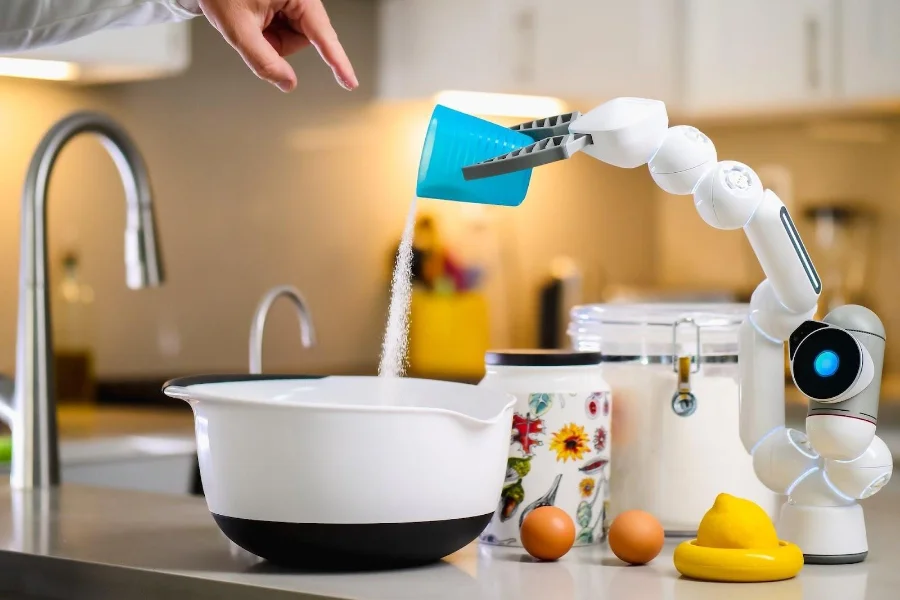The food and beverage industry is a dynamic environment constantly changing thanks to technological advancement and evolving consumer choices. In such a sphere, good machinery plays a vital role in ensuring that businesses meet the demands of a fast-paced and environmentally conscious industry.
This article will highlight five rising food and beverage machinery market trends shaping the industry. Thanks to their quality, efficiency, and productivity, brands can transform their food production and processing chain to revolutionize their landscape and stay ahead of the competition.
Table of Contents
What is the size of Southeast Asia’s beverage machinery market?
Five food and beverage machinery trends in Southeast Asia
Special requirements for machinery in Southeast Asia
Rounding up
What is the size of Southeast Asia’s beverage machinery market?
The market for food processing equipment in Southeast Asia was valued at USD 993.90 million in 2017 and it should grow to USD 1.434 billion by 2025, with a compound annual growth rate (CAGR) of 4.7 from 2018 to 2025.
Food processing machinery involves tools that facilitate the commercial manufacturing and packaging of food products such as baked items, beverages, dairy, meat, and seafood amongst others.
Previously, standard food manufacturing equipment was designed to perform just one function at a time, but presently, advanced machines can perform several automated operations at once.
Based on type, the market is divided into bakery, dairy, beverage, fruits and vegetables, chocolate and confectionery, meat, poultry and seafood, and other food processing equipment. Meat, poultry, and seafood equipment dominated the market in 2017. This is because the by-products are widely available and highly consumed, especially in recent decades, fueling growth within the segment. Meat processing machinery has improved technology that maximizes nutrient retention and increases shelf life without affecting the quality.
Regionally, the market is shared among Indonesia, Malaysia, Vietnam, Thailand, Philippines, Singapore, and the rest of Southeast Asia. Indonesia held the highest revenue in 2017, owing to the increased demand for processed food. Additionally, replacing traditional tools and manufacturing equipment in Southeast Asia countries will drive market growth.
Five food and beverage machinery trends in Southeast Asia
Easier tasks with automation

Automation technologies make tasks easier by replacing manual labor with automated systems. It helps companies to enhance productivity by streamlining processes and simplifying repetitive tasks. Automated systems like the ERP can facilitate backend functions such as inventory management, staff scheduling, and supply chain operations, allowing smoother logistics and other business operations.
Businesses can employ automated machines in the form of artificial intelligence and chatbots in online ordering setups that enhance personalized consumer ordering and fast delivery services.
Moreover, automated equipment also contributes to operational efficiency by significantly reducing food processing cycle times, thereby increasing output. Such equipment like robotic arms and conveyor systems can do labor-intensive tasks with high speed and accuracy, eliminating the chances for human error and reducing production costs. These machines can operate continuously without breaks, so businesses can meet consumer demands more effectively and maximize overall sales.
Furthermore, automated machines reduce the risks of human exposure to dangerous manufacturing tasks like operating heavy machinery or working with hot equipment. Thus by investing in these machines, businesses can ensure the safety of their employees and a healthy working environment.
Labor-reducing equipment
One of the key reasons for adopting this trend is the decreasing size of restaurant kitchens. Companies are now seeking innovative solutions in terms of equipment that run smarter and smaller, which saves labor costs and makes training more accessible.
By endorsing these machines, businesses can spare human resources for other activities that require people to make decisions and solve problems creatively. It addresses labor shortages and skill gaps in the food and beverage industry, especially in regions with many demanding manual tasks and fewer skilled workers.
One example of these machines is the QuiQsilver Roll-O-Matic silverware roller which can wrap various flatware in napkins at 500 sets per hour. It also packages and rolls chopsticks. Most impressively, it cleanses and sanitizes each set using a built-in ultraviolet light as it operates.
Better food safety with smart technology
One study shows that 94% of customers are more likely to be loyal to a food brand that offers complete food supply chain transparency. Luckily, businesses can achieve such a level of trust by leveraging smart technology that utilizes Internet of Things (IoT) devices, data analytics, and sensors.
These equipment play a pivotal role in ensuring food safety in all stages of production, guaranteeing the highest food safety standards. Some of their key uses in the food and beverage industry include:
- Real-time monitoring and data collection over the entire production process.
- Tracking of critical parameters such as pH values, temperature, and humidity using embedded sensors.
- Regulating and optimizing processes such as food mixing and packaging.
- Providing valuable insights into food quality using data analytics techniques.
- Identifying potential anomalies and deviations in the manufacturing and storage environment and triggering alerts to notify the relevant personnel to take necessary action.
Additionally, these machines reduce the need for human interaction with food processing, thereby reducing the risk of cross-contamination and other health-related issues. Even digital tools and mobile apps let brands create a checklist for tracking food safety audits and results. Businesses may publish this record of the product’s journey to foster transparency and gain the trust of their consumers.
Digitization through enhanced IT
Businesses looking to expand their IT infrastructure and improve their networks should consider integrating enhanced information technology systems to optimize efficiency and transparency and enable data-driven decision-making. These include:
- SD-wide area networks for reliability and app control.
- Strong WiFi networks for both backend and customer-facing internet services.
- Cybersecurity software for protecting delicate data.
They can also include systems that provide real-time inventory tracking, and details on stock levels, expiration dates, and locations, thus fostering seamless collaboration and coordination.
Also, IT systems help companies make informed decisions during product development, resource allocation, and pricing strategies using analyzed data on consumer preferences, production performance, and market trends. This approach allows businesses to easily and swiftly adapt to changing market demands.
Efficient food production with robotics

Robots are built to perform repetitive tasks with great speed and precision tirelessly. These machines can carry out tasks such as picking, packaging, and sorting in a significantly shorter time than humans.
Moreover, meticulous operations like weighing, proportioning, and ingredient mixing, where slight deviations can significantly impact product quality, are best suited for robots due to their unmatched level of consistency. Their speed and efficiency are especially crucial during peak periods and high-demand situations, as robots can maintain high productivity without compromising on quality.
Also, robots can function in hazardous environments and handle more dangerous equipment precisely, ensuring worker safety and product integrity. For instance, robotic butchers can cut meat intricately, relieving employees to work on less risky tasks.
Special requirements for machinery in Southeast Asia

Southeast Asia’s food and beverage machinery ought to meet specific considerations, like the following:
- Safety and hygiene compliance: machines must meet sanitary requirements and be designed with easy-to-clean surfaces to facilitate proper cleaning and prevent contamination of food products.
- Adaptability: Southeast Asia is known for having a diverse cuisine, some of which require unique food processing techniques. Thus, food processing machines should be designed with flexibility and easy adaptability.
- Power efficiency: Energy costs are typically high in this region, so energy-efficient machines are crucial to minimizing power expenses while maintaining manufacturing processes.
- Space management: Rapid urbanization places restrictions on real estate availability, causing most restaurant kitchens to be frugal in terms of space. Thus, compact and rearrangeable equipment is particularly critical in the market.
- Scalability: machines should offer cost-effective solutions for small businesses while allowing for expansion where needed.
Rounding up
Southeast Asia’s vibrant and diverse food and beverage market requires robust and advanced technologies to suit its various needs. Each of the five trends addresses specific issues and significantly benefits all aspects of the food and beverage industry.
Businesses can ensure that they continue to thrive amidst the constantly evolving market by investing in these top trends, which enhance operational efficiency, improve product integrity, meet consumers’ demands, and build trust. All these and more will enable them to be at the forefront of innovation and gain a competitive advantage in the expanding industry.




